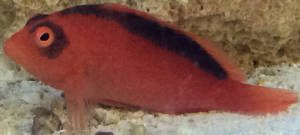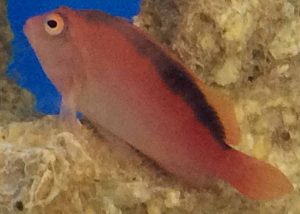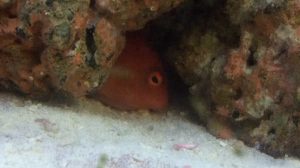
Neocirrhites armatus
| Difficulty | Low |
| Minimum Tank Size | 30 Gallons |
| Diet | Carnivore |
| Water Parameters | 72-78 F, pH 8-8.4, Salinity 1.020-1.025 |
| Aggression | Semi-Aggressive |
| Size | 4" |
These brilliant red fish can easily capture any passers eye. Their bright colors, quick movements and sharp eyes show that they are no ordinary fish.
When kept in home aquariums the Flame Hawkfish (Neocirrhites armatus) will sit still watching the inhabitants of the room, quickly darting to new vantage points occasionally. While this may make them seem timid and peaceful, the Flame Hawkfish actually houses a semi-aggressive temperament. If you wish to keep this fish in your home, there’s quite a few things you’ll need to learn.
Feeding The Flame
Despite their cute looks and small size, the Flame Hawkfish is actually a carnivorous fish who lunges quickly from its perch to attack their prey. This attitude makes them excellent hunters who are unlikely to go hungry during feeding times. The best foods for Flame Hawkfish are:
- Mysis Shrimp
- Squid
- Brine Shrimp, Enriched if possible
- Prepared Food(Flake/Pellets)
- Frozen cubes, thaw before use to prevent water contamination
Feeding should occur once a day, with most fish actually only needing food every other day. However by choosing every other day owners can stunt their fishes growth and cause hawkfish to quickly lose their colors.

A sick Flame Hawkfish that has lost its color
For tanks with few fish, be sure to get the attention of at least one fish before you begin feeding. Hawkfish will often watch the owner and are great fish at starting the feeding frenzy.
When first introduced into the tank the Flame Hawkfish will be unlikely to accept prepared foods. By feeding the flame in a consistent manner, they will quickly recognize when they are being fed. At this point they will often accept the prepared food without problem. Stress levels may revert the fish into not accepting prepared foods. Be sure to keep frozen food on hand incase they refuse to eat.
When malnourished, either through an incomplete diet or simple lack of food, the Flame Hawkfish will begin to lose its color and swim more frantically. To restore color and composure round out their diet by offering a wider variety of foods. Vitamins and omega 3 fatty acids are often the culprit of missing color. Watch the hawkfish and ensure they are eating. Often these smaller fish can be scared away from the feeding areas. Likewise ensure the hawkfish itself is not preventing other fish from eating. If needed feed the top level fish at the same time that you feed the bottom level. You can accomplish this using a turkey baster or rigid tubing.
While Flame Hawkfish can eat larger cleaner shrimps, crabs and snails. This is not an advised method and should not be encouraged. Allowing your flame to frequently eat new clean up crew members will endanger the existing members and increase the flames level of aggression. Owners who wish to feed their hawks live foods are advised to start up brine shrimp cultures.
Flame Hawkfish Territories
Housing a single Flame Hawkfish requires a 40 gallon tank or larger, with water parameters of 1.023 salinity and a pH of 8.3 being optimal levels. With hawkfish length is better than height as these fish love to swim across rather than up and down. Despite this fact, Flame Hawkfish must have a secure lid. They are highly prone to jumping when startled and can spot a hole in the cover very easily. Cover all cut-outs with a mesh screen to prevent accidental escapes. As for water flow, flames prefer a high flow tank with few dead zones. The high water flow supports their next demand of highly aerated water. As your water disturbs the surface more air is exchanged into the tanks water. With more water flow the exchange happens at a much larger scale that the hawkfish enjoys.
Additionally Flame Hawkfish need multiple ledges and caves to duck and weave around. After inspecting the tank fully the hawkfish will select two territories. One ledge to watch the tank from and their cave. During the day the flame will often rest upon its ledge, watching the tank and those outside. From here they will eat any passing food or attack prey. Once they sense danger or quick movement the hawk will often dash back into it’s cave and wait until things are safe. This is the trait that most owners love as the hawkfish will actually interact with their owners, much more than other fish who only beg for food.
During night time the Flame Hawkfish will retreat into it’s cave and rest for the night. While they are resting, their eyes never stop watching the tank and they will still quickly run from any threats.

The Flame Hawkfish peeks out of it’s den
Because the Flame Hawkfish are highly skittish, sumps and exterior bodies of water are highly recommended. These allow the owner to perform and water changes without startling the fish. Sudden changes and new water flows can cause the Flame Hawkfish to jump, making water changes directly to the display tank more dangerous. If you do not have a sump take great care not to startle your hawkfish and always ensure they are safe and sound once the change is finished.
Flame Hawkfish are Reef Safe
Many coral owners shy away from owning hawkfish. While there are stories of hawkfish nipping at corals this is a very rare case. Flame Hawkfish are classified as reef safe and should not harm corals. The only exception is they will often use harder corals as ledges, as the branch like arms offer them easy mobility in a small area. Most hard corals will not be affected by the hawks attention and their presence can even keep away many tank mates who would bother the corals. In addition to being reef safe, the Flame Hawkfish greatly prefers strong lights, making them a perfect pair for many SPS corals.
However this is where their aggression can cause issues. Tanks with many small shrimp and crabs can see their population quickly diminish. Small prey approaching corals to pick at their membranes will often be chased off or attacked by the Flame Hawkfish. This leaves tanks with only larger invertebrates and can stop new ones from maturing. To combat this effect, give your invertebrate plenty of hiding spots such as crevices under rocks at the bottom of the tank. When given their own separate areas, crab, shrimp and flames can easily be kept together with few signs of aggression.
Finally when introducing new invertebrates in the same tank as your flame, be sure to release them at night and in very rocky areas. Most Flame Hawkfish will see this as a feeding and move in quickly to eat even the larger creatures. Once the invertebrates have had a chance to settle in, they will often be safe from the flame hawks hungry mouth.
Flame Hawkfish Aggression
Due to their small mouths the flame poses one of the lowest threats of the hawkfish species. This means the Flame Hawkfish can be kept with other small fish without fear of attack. That being said the Flame Hawkfish is not entirely peaceful and poses many threats owners will need to consider before adding the hawk to their tank. Those in danger are:
- Clean up Crew Members(Snails, Shrimp, Crabs
- Slow Moving Bottom Dwellers(Small Gobies & Mandarins)
- Young Fish
While the list may seem intimidating, all but the clean up crew threats will never be seen in most tanks. Young fish should be allowed to reach at least one inch before introduction into the tank for safe results. An additional measure you may use to lower aggression is to re-arrange your Flame Hawkfish’s territories right as you introduce the new fish. This makes the flame more interested in securing a new home than harassing new tank mates.
Not All Hawks Are Bad:
Many owners will receive hawkfish that will not attack anything at all in their new tank. Some owners have even reported their hawkfish harassing fish over twice their size. For safety reasons we suggest you treat new hawkfish as the most aggressive hawk possible, however many will remain docile and coincide with even the smallest of prey animals.
Housing multiple Flame Hawkfish is reserved for those tanks of 50 gallons or above. For more than 2 hawkfish owners will often need tanks that exceed 200 gallons. The main problem with housing multiple Flame Hawkfish arises when the flames are not purchased at a young age. This will be explained in the next section.
Breeding Flame Hawkfish
Hawkfish have the same trait as clown fish known as protogynous. Species with this trait are all born female and will only change to male under certain circumstances. For the Flame Hawkfish the most dominant of the group will change genders and become the only male in the group. This results in haremic reproduction where one male will mate with all the females. For this reason new Flame Hawkfish should only be added together when they are very young and have not yet changed genders. Introducing multiple adult flames will almost never be successful even in tanks over 100 gallons in size.
This does not mean that once a hawkfish is male it can never meet another male. Studies performed by Professor Terry Donaldson have shown the ability of Bidirectional sex changing in hawkfish. This requires that the two hawkfish are not close to the others size or aggression level. When one if far more dominant than the other, the smaller less dominant will revert back into a female as the two pair.
The Flame Hawkfish will mate at night. To encourage breeding owners must:
- Keep the Temperature at 80 degrees Fahrenheit
- Provide plenty of high quality food
- Be Consistent With Lighting and Water Flow
- Provide at Least 80 Gallons of Space
One the mating ritual is complete you must collect the eggs and house them in a safe environment. In the wild hawkfish will release thousands of eggs that will float around in the water column. watch for the eggs and continue to collect until no more can be seen. The second tank should have similar parameters to the old tank. Always have a secure lid with a wide body of water for breeding fry to allow maximum water efficiency. Breeders can expect the new fish to hatch after three weeks.
Live enriched brine shrimp and copepod cultures are the best food choices for raising the new fry as they are easily maintained in their own chambers. Fry do not need to be separated and will live together peacefully. Be sure you use a container that is large enough to support their growth. As the fry get older they will put a much larger load on the biological filtration, making frequent water changes essential. Failure to do so will result in the death of fry. In addition keep a tight lid on the fry’s cage, as the hawkfish is highly prone to jumping.
Remember: Frequently check the water parameters of the fry’s cage. Young fish are much more sensitive to poor water quality and can easily die off if the tank is not properly monitored. Check the water at least once a week. Daily testing is much safer but is not always needed. Ensure no dead fish are allowed to remain in the tank. It is unlikely that all the fry will survive, making removal a necessary process. This causes a major problem for breeders as the fry are highly prone to jumping away during traditional means of fish removal. Be as slow and non threatening as possible, leaving little room open for jumping fish to escape. It is for this reason larger than normal breeding tanks are desired.
As the fry age you will need to provide a new home. Usually this means selling the hawkfish to local aquarist and club members, or even donating the fish to another family member. Only introduce new Flame Hawkfish to your original tank if the previous flames are no longer present or if the tank is above 200 gallons in size. Older hawkfish are prone to attacking small fish, meaning these new hawkfish must be allowed to age more than usual if they are to be added into a tank already containing aggressive fish.